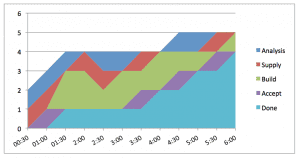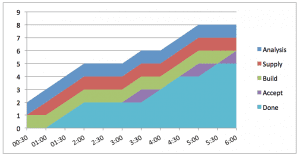I have just published a page for the Lego Flow Game – a new game that I have co-created with Dr. Sallyann Freudenberg. Its based on an ‘experiment’ I originally ran in 2010 at the SPA conference. Then I used an exercise of matching, solving and checking equations to explore and experience workflow with different types of processes and policies. While this worked in terms of having a game that consisted of knowledge work, it turned out to be painfully tedious and hard work, which detracted from the main learning objectives. Sal was in the audience that day, and took the concept and evolved it by swapping in Lego building instead of the mathematics. We’ve run the updated version a few time over the last 6 months or so, and made some tweaks to the rules and timings, and we’re pretty happy with the latest version – hence publishing it.
The most recent outing was at the Kanban Coaching Exchange in London last week. It was pretty chaotic with around 50 people attending in a relatively small space, and only 3 full kits – we need to stock up on staplers! That meant that there were lots of observers – if you were there, we thank you for your patience. It didn’t help that we were also missing the right cable to connect a laptop to the TV in the room, so we had to explain the exercise without any supporting slides, and I had to show the end-result Cumulative Flow Diagrams by holding my laptop over my head. Given all that, there seemed to be high energy, good discussion and overall the feedback seemed positive. If we can run the exercise successfully in that environment, then it’ll probably work in most situations!
You can find the full instructions on the main page – please let us know if anything isn’t clear. You’ll also find the slides and spreadsheet to go with the exercise there. There are some photographs from the Kanban Coaching Exchange session on the event page and I’ll add any others that I come across here as well.
Here are the final spreadsheets for the 3 teams. I’ll briefly describe what I interpret from one of them (team 1).
Round 1 is a ‘waterfall-like’ process, or batch and stage. In other words, the work flows through the process in a single batch, one stage at a time. You can see the work build up in the Analysis stage until all 5 are complete, and then moved together into Supply stage, and then Build, where the team ran out of time. Thus no items were completed. The debrief of this round mentioned that the person working felt very pressured, while everyone else was very relaxed. Waterfall is great if you’re not the critical path – and you don’t care about getting anything done!
Round 2 is a ‘scrum-like’ process, or time-boxed, with 3 x 2 minute ‘Sprints’. The time-boxes themselves are not obvious from the CFD, but its clear that there is some more flow, even if it is fairly ragged. One item is completed in the the first time-box, but the team estimated, and started four items. However, they must have learned from this, because they didn’t start anymore work in the second time-box (between minutes 2:00 ad 4:00) and they completed one more item on this time-box. For the final time-box, they decided to start one more item, and complete 2 more. If they had seen the data and the graph (I didn’t show anything until the end) they might have realised that it probably wasn’t worth starting anything in the final time-box either. Four items were completed in total. You can also start to see some predictability at the end as the built in retrospective cadence generated learning and improvement in how much work the team took on. The debrief discussed how this round tends to feel fairly chaotic with strong focus, punctuated by the retrospectives.
Round 3 is a ‘kanban-like’ process, or purely flow-based with WIP limits. The flow is much smoother this time, and the WIP limit of 1 in each stage is clear. The slope of the graph is also fairly smooth, and its would probably be fairly easy to predict the future performance of the team. Five items were completed at almost one per minute. The debrief discussed how this round tends to be more relaxed, with a more gently hum of activity.
I hope this is useful in getting a feel for how the game works, and making it possible to run the game yourself. Please try it for yourself and let us know how you get on. In particular Sal and I would love to hear about modifications you make, or what other policies you experiment with.




[…] Announcing The Lego Flow Game […]
Hi Karl, this looks great, thanks! I think it is a good way to simulate knowledge work. Made me order advent calendars in Spring, yay 🙂
One question – did you ever try to run this without defining the process from the beginning, i.e. letting it emerge? I could imagine a variant of this as just giving them the stuff and the task at hand and let them figure it out themselves (gentle nudging them into the right direction if needed 😉
Cheers! Susanne
Hi Susanne
I’ve not tried this. Sounds like something that would be interesting to try. If you do, please post back here what happens!
Karl